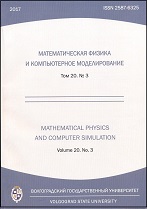|
Mathematics
Construction of the solutions of the Monge–Ampere type equation based on $\Phi$-triangulation
V. A. Klyachin, M. I. Kazanin
Volgograd State University
Abstract:
In the article we considered the method of geometric construction of piecewise linear analog solutions discrete form of the equation
$$
u_{x_1x_1} u_{x_2x_2} -u_ {x_1x_2}^ 2 = F (u_{x_1}, u_{x_2}) \varphi (x_1, x_2).
$$
The idea of the method is based on the approach suggested by A. D. Aleksandrov to prove the existence of a classical solution of the above equation. Note that the geometric analog of the problem being solved in this article is the problem of A. D. Aleksandrov on the existence of a polyhedron with prescribed curvatures of vertices. For piecewise linear convex function
we defined curvature mesuare $\mu(p_i)$ of vertex $p_i$ in terms of function $F(\xi_1,\xi_2)$. The solution is defined as piecewise linear convex function with prescribed values $\mu(p_i)=\varphi_i, i=1,...,N$. The relation $\Phi$-triangulations of given set of points $\xi_i,i=1,...,M$ with piecewise linear solutions is obtained. The construction of solution is based on analog of Legendre transformation of kind
$$
f(x) = \min_{i = \overline{1,M}} \{ \Psi(\xi_i) + \left\langle \nabla \Psi (\xi_i) , x - \xi_i \right\rangle \}.
$$
As a corollary we proved the following result.
Theorem 2.
Let $ T $—classical Delaunay triangulation of a set of points $ {\eta} _ {1}, ..., {\eta} _ {M} \in \mathbb {R}^2 $ with triangles $ \Delta_1 ,. .., \Delta_N $ such that $ \mu_F (\Delta_i) = \varphi_i, i=1,...,N $. Then there is a piecewise linear function satisfying the equations
$$
\mu(p_i)=\varphi_i, i=1,...,N.
$$
Morever, the required solution $ f (x) $ defined by
$$
f(x) = \min_{i = \overline{1,M}} \left\{ \frac{1}{4}|\eta_i|^2 + \left\langle \eta_i , x -\frac{1}{2} \eta_i \right\rangle \right\}.
$$
Keywords:
convex polygonal surface, piecewise linear function, triangulation, convex set, Monge–Ampere equation.
Citation:
V. A. Klyachin, M. I. Kazanin, “Construction of the solutions of the Monge–Ampere type equation based on $\Phi$-triangulation”, Vestnik Volgogradskogo gosudarstvennogo universiteta. Seriya 1. Mathematica. Physica, 2017, no. 1(38), 6–12
Linking options:
https://www.mathnet.ru/eng/vvgum158 https://www.mathnet.ru/eng/vvgum/y2017/i1/p6
|

|




 Contact us:
Contact us: Terms of Use
Terms of Use
 Registration to the website
Registration to the website Logotypes
Logotypes








 Citation in format
Citation in format 